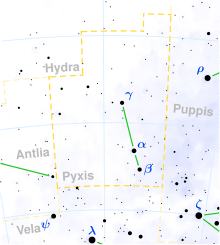Gamma Pyxidis
 | |
| Observation data Epoch J2000 Equinox J2000 | |
|---|---|
| Constellation | Pyxis |
| Right ascension | 08h 50m 31.92282s[1] |
| Declination | −27° 42′ 35.4421″[1] |
| Apparent magnitude (V) | 4.010[2] |
| Characteristics | |
| Spectral type | K3 III[2] |
| U−B color index | +1.368[3] |
| B−V color index | +1.284[3] |
| Astrometry | |
| Radial velocity (Rv) | +24.5±0.7[4] km/s |
| Proper motion (μ) | RA: −134.31[1] mas/yr Dec.: 87.89[1] mas/yr |
| Parallax (π) | 15.73 ± 0.17[1] mas |
| Distance | 207 ± 2 ly (63.6 ± 0.7 pc) |
| Absolute magnitude (MV) | +0.00[5] |
| Details | |
| Mass | 1.64[2] M☉ |
| Radius | 21.87[6] R☉ |
| Luminosity | 178[7] L☉ |
| Surface gravity (log g) | 2.35[8] cgs |
| Temperature | 4,270[8] K |
| Metallicity [Fe/H] | −0.05[8] dex |
| Age | 4.29±2.49[6] Gyr |
| Other designations | |
| Database references | |
| SIMBAD | data |
Gamma Pyxidis, Latinized from γ Pyxidis, is a single,[10] orange-hued star in the southern constellation Pyxis. It is visible to the naked eye, having an apparent visual magnitude of 4.010.[2] Based upon an annual parallax shift of 15.73 mas as seen from Earth,[1] it is located about 207 light years from the Sun. The star is moving further from the Sun with a radial velocity of +24.5 km/s.[4]
Properties
This is an evolved K-type giant star with a stellar classification of K3 III.[2] It is a red clump star on the horizontal branch,[11] indicating that it is generating energy through helium fusion at its core. The composition of the stellar atmosphere is similar to the Sun, having roughly the same abundance of iron in its spectrum.[12] The star has an estimated 1.64[2] times the mass of the Sun and has expanded to nearly 22[6] times the Sun's radius. At the age of around four billion years, it is radiating 178[7] times the Sun's luminosity from its enlarged photosphere at an effective temperature of 4,270 K.[8]
Gamma Pyxidis is moving through the Galaxy at a speed of 54.2 km/s relative to the Sun. Its projected Galactic orbit carries it between 21,300 and 30,700 light years from the center of the Galaxy.[13]
Naming
In Chinese, 天狗 (Tiān Gǒu), meaning Celestial Dog, refers to an asterism consisting of γ Pyxidis, e Velorum, f Velorum, β Pyxidis, α Pyxidis and δ Pyxidis. Consequently, γ Pyxidis itself is known as 天狗六 (Tiān Gǒu liù, English: the Sixth Star of Celestial Dog.)[14]
References
- 1 2 3 4 5 6 van Leeuwen, F. (2007). "Validation of the new Hipparcos reduction". Astronomy and Astrophysics. 474 (2): 653–664. arXiv:0708.1752. Bibcode:2007A&A...474..653V. doi:10.1051/0004-6361:20078357.
- 1 2 3 4 5 6 Luck, R. Earle (2015), "Abundances in the Local Region. I. G and K Giants", Astronomical Journal, 150 (3), 88, arXiv:1507.01466, Bibcode:2015AJ....150...88L, doi:10.1088/0004-6256/150/3/88.
- 1 2 Gutierrez-Moreno, Adelina; Moreno, Hugo (June 1968), "A photometric investigation of the Scorpio-Centaurus association", Astrophysical Journal Supplement, 15: 459, Bibcode:1968ApJS...15..459G, doi:10.1086/190168
- 1 2 Gontcharov, G. A. (November 2006), "Pulkovo Compilation of Radial Velocities for 35495 Hipparcos stars in a common system", Astronomy Letters, 32 (11): 759–771, arXiv:1606.08053, Bibcode:2006AstL...32..759G, doi:10.1134/S1063773706110065.
- ↑ Anderson, E.; Francis, Ch. (2012), "XHIP: An extended hipparcos compilation", Astronomy Letters, 38 (5): 331, arXiv:1108.4971, Bibcode:2012AstL...38..331A, doi:10.1134/S1063773712050015.
- 1 2 3 Reffert, Sabine; et al. (2015), "Precise radial velocities of giant stars. VII. Occurrence rate of giant extrasolar planets as a function of mass and metallicity", Astronomy & Astrophysics, 574: A116, arXiv:1412.4634, Bibcode:2015A&A...574A.116R, doi:10.1051/0004-6361/201322360.
- 1 2 Mallik, Sushma V. (December 1999), "Lithium abundance and mass", Astronomy and Astrophysics, 352: 495–507, Bibcode:1999A&A...352..495M
- 1 2 3 4 Cenarro, A. J.; et al. (2007), "Medium-resolution Isaac Newton Telescope library of empirical spectra - II. The stellar atmospheric parameters", Monthly Notices of the Royal Astronomical Society, 374 (2): 664&ndash, 690, arXiv:astro-ph/0611618, Bibcode:2007MNRAS.374..664C, doi:10.1111/j.1365-2966.2006.11196.x
- ↑ "gam Pyx", SIMBAD, Centre de Données astronomiques de Strasbourg, retrieved 2009-06-03
- ↑ Eggleton, P. P.; Tokovinin, A. A. (September 2008), "A catalogue of multiplicity among bright stellar systems", Monthly Notices of the Royal Astronomical Society, 389 (2): 869–879, arXiv:0806.2878, Bibcode:2008MNRAS.389..869E, doi:10.1111/j.1365-2966.2008.13596.x.
- ↑ Alves, David R. (August 2000), "K-Band Calibration of the Red Clump Luminosity", The Astrophysical Journal, 539 (2): 732–741, arXiv:astro-ph/0003329, Bibcode:2000ApJ...539..732A, doi:10.1086/309278.
- ↑ Keenan, Philip C.; Barnbaum, Cecilia (June 1999), "Revision and Calibration of MK Luminosity Classes for Cool Giants by HIPPARCOS Parallaxes", The Astrophysical Journal, 518 (2): 859–865, Bibcode:1999ApJ...518..859K, doi:10.1086/307311
- ↑ Gamma Pyxidis (HIP 43409)
- ↑ (in Chinese) AEEA (Activities of Exhibition and Education in Astronomy) 天文教育資訊網 2006 年 7 月 17 日